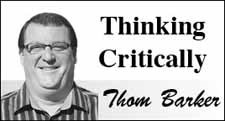One of the greatest icons in the history of science passed away two weeks ago. Neil Armstrong was the first member of our species to set foot on another world. Armstrong was known more as an astronaut than an engineer, but he is the face of one of the most remarkable scientific accomplishments in the history of humanity. And that seminal moment in space exploration when his boot touched lunar soil represents the best of what we are.
Of course, putting people on the moon was barely the beginning of our exploration of space. We have now discovered hundreds of planets circling other stars. With this evidence, it now appears more than likely planets exist everywhere in the universe. And in a universe that contains hundreds of billions of galaxies each of which comprises millions to hundreds of billions of stars, the number of planets out there is probably countless. It is the best evidence we have to date that we are not alone.
But that is the great thing about science. Because we do not yet have direct evidence life exists elsewhere, legitimate scientists would never state as a fact it does. Real science demands empirical proof. And if the proof is out there, we will find it because that is what we do. Ever since our big brains evolved to the point that we were able to observe and predict, then experiment and confirm, great minds have dared to challenge preconceived notions and drag us kicking and screaming toward greater understanding of the nature of reality.
The greatest gifts my parents ever gave me were the desire and ability to think critically. My intention with this column is to examine scientific issues that affect society. Science is not perfect. By its very nature it seeks to overturn its own outdated ideas. At any given time, however, good science is the best shot we have at solving our problems.
For me, as a journalist, these few inches of ink on newsprint represent coming full circle. During the 1991-1992 school year, I was science and health editor for The Charlatan, Carleton University's student newspaper. I was the first (and possibly still the only) non-journalism student to hold an editorial post for an entire year (they even gave me a certificate). I volunteered for the job because I felt the paper was doing a poor job of science coverage.
Journalism students tended to struggle with science topics and science students tended to struggle with putting together a coherent English sentence. As a science student who had a penchant for writing, I felt I could bridge the gap and wrote a weekly science column called "Bridging the Gap."
Mainstream media has never been in a worse position to provide adequate science coverage. At the same time our cumulative scientific knowledge has grown exponentially in volume and complexity, newsroom budgets have been disappearing like Arctic ice.
When you add to that the concerted effort of special interest groups to manufacture controversy and abuse scientific data, it becomes very difficult at times to distinguish fact from fancy. Furthermore, we are frequently hog-tied by the honourable, but frequently misguided, concept of "balanced" coverage. In an effort to tell both sides of a story, we often unintentionally lend credence to crackpots and special interest "scientists" whose only intention appears to be to drive a wedge between the legitimate science community and the public.
It was 43 years ago that Neil Armstrong took the step he called a "giant leap for mankind." It is through critical thinking that we follow in his momentous footsteps.




